Picture |
Object
name
#NORAD |
Description |
Launch
Date |
Weight |
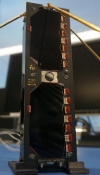
|
Delfi-PQ
Delfi PQ 1
#51074
(2022-002CU) |
The Delfi-PQ (or
Delfi-PocketQube) mission is a picosatellite developed
in the ‘Delfi Program’ of the Technical University of
Delft built to the 3P PocketQube form factor. Delfi-PQ
consists of a core platform which secures basic functionalities
which will iteratively evolve over time. Advanced subsystems,
suchs as for instance attitude determination and control,
as well as payloads will be developed as separate projects
using a standard interface specification. Only when
they are ready in hard- and software, and can be successfully
integrated and tested, they become a formalized part
of the next satellite, either as a technology demonstration
payload or as extended capability of the core platform.
Once the first complete hardware baseline exists, there
will be always be a launch-worthy satellite planned
ready for integration.
Delfi PQ 1 was operational
until it decayed on January 6th 2024. |
Jan.
13th 2022 |
3
kg |
 On February
23rd 2023 at 20:25 UTC Daniel
DL7NDR received on 436.650 MHz the 1200bd FSK beacon.
Recording kindly provided by Daniel DL7NDR. On February
23rd 2023 at 20:25 UTC Daniel
DL7NDR received on 436.650 MHz the 1200bd FSK beacon.
Recording kindly provided by Daniel DL7NDR.
|
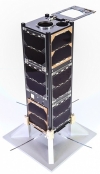
|
VZLUSAT-2
#51085
(2022-002DF) |
VZLUSAT-2 is a 3U
CubeSat by the Czech Aerospace Research Center, launched
with SpaceX on January 13th 2022.
The primary payload of the mission are two experimental
Earth observation cameras, secondary payloads include
radiation monitoring instruments, gamma ray burst detectors
and X-ray detectors. |
Jan.
13th 2022 |
3
kg |
 On October
15th 2022 at 20:48 UTC Daniel
DL7NDR received on 437.325 MHz the 4800bd GMSK beacon.
Recording kindly provided by Daniel DL7NDR. On October
15th 2022 at 20:48 UTC Daniel
DL7NDR received on 437.325 MHz the 4800bd GMSK beacon.
Recording kindly provided by Daniel DL7NDR.
|

|
INSPIREsat-1
IS1
SUCHAI3
MinXSS 3
#51657
(2022-013B) |
INSPIREsat-1 (International
Satellite Program in Research and Education 1) is a
student satellite developed by Indian Institute of Space
Science & Technology (IIST), in association with
University of Colorado, USA. Other contributors
are NTU, Singapore and NCU, Taiwan.
INPIRESat-1 is a
pathfinder for international collaboration in space
science missions carrying payloads and spacecraft components
developed by multiple nations. The two science payloads
onboard the spacecraft are:
- A NASA-funded
payload called the Dual Aperture X-Ray Solar Spectrometer
(DAXSS) that will measure solar radiation in soft X-Rays
to better understand solar coronal heating processes.
This payload is also called MinXSS 3 and is based on
the instrument flown on MinXSS 1 and 2.
- An in-situ Ionosphere
probe called the Compact Ionosphere Probe (CIP) developed
by NCU. |
Feb.
14th 2022 |
8
kg |
 On September
30th 2022 at 17:00 UTC Daniel
DL7NDR received on 437.500 MHz the 9600bd GFSK beacon.
Recording kindly provided by Daniel DL7NDR. On September
30th 2022 at 17:00 UTC Daniel
DL7NDR received on 437.500 MHz the 9600bd GFSK beacon.
Recording kindly provided by Daniel DL7NDR.
|
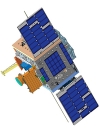
|
INS-2TD
#51658
(2022-013C) |
INS 2TD (ISRO NanoSatellite
2TD) is a nanosatellite developed by ISRO as a technology
demonstrator satellite, which is a precursor to the
India-Bhutan joint satellite (INS-2B).
Having a thermal
imaging camera as its payload, the satellite benefits
the assessment of: land surface temperature; water surface
temperature of wetlands/lakes; delineation of vegetation
(crops and forest); and thermal inertia (day/night). |
Feb.
14th 2022 |
18
kg |
 On October
21st 2022 at 06:42 UTC Daniel
DL7NDR received on 435.080 MHz the 1200bd FSK beacon.
Recording kindly provided by Daniel DL7NDR. On October
21st 2022 at 06:42 UTC Daniel
DL7NDR received on 435.080 MHz the 1200bd FSK beacon.
Recording kindly provided by Daniel DL7NDR.
|
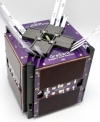

|
OreSat0
Oregon Satellite 0
#52017
(2022-026K) |
OreSat 0 (Oregon
Satellite 0) is an 1U CubeSat mission by Portland State
University to provide flight heritage to the OreSat
bus, an
open source card-cage based system that is ideally suited
for education CubeSat projects involving interdisciplinary
teams of students.
It was launched
to a 525 km sun synchronous low earth orbit aboard Astra's
LV0009 rocket on March 15th 2022. |
March
15th 2022 |
1
kg |
 On October
27th 2022 at 05:13 UTC Daniel
DL7NDR received on 436.500 MHz the 9600bd GMSK beacon.
Recording kindly provided by Daniel DL7NDR. On October
27th 2022 at 05:13 UTC Daniel
DL7NDR received on 436.500 MHz the 9600bd GMSK beacon.
Recording kindly provided by Daniel DL7NDR.
|
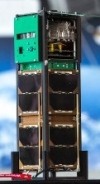
|
PLANTSAT
#52188
(2022-033AH) |
PlantSat (Satellite
of the University of Chile for Aerospace Investigation)is
a 3U CubeSat satellite, built by students and engineers
of the University of Chile. Its main mission is to monitor
the behavior of a plant in a microgravity environment
and in extreme conditions of solar radiation.
Its goal is to study
in low earth orbit the growth of a suitable plant, replicating
the conditions that life will experience on Mars’ surface.
These conditions include low gravity force and high
solar radiation.
The 3U CubeSat satellite,
provided by GomSpace, consists of two units containing
the satellites systems (based on SUCHAI 2) and one unit
consisting of the biosphere payload. The proposed plant
genus for PlantSat is Tillandsia. This is a hardy genus
that can be found all across the neotropics, high up
in the mountains of the Andes and down to the shores
of the Atacama desert. This hardiness and versatility
makes it an excellent candidate for survival in harsh
environments.
Plantsat was launched
on a Falcon 9 rocket. |
April
1st 2022 |
~3
kg |
 On September
9th 2022 at 10:33 UTC Daniel
DL7NDR received on 437.240 MHz the 4800bd GMSK beacon.
Recording kindly provided by Daniel DL7NDR. On September
9th 2022 at 10:33 UTC Daniel
DL7NDR received on 437.240 MHz the 4800bd GMSK beacon.
Recording kindly provided by Daniel DL7NDR.
|
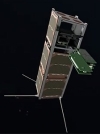
|
SUCHAI-3
SUCHAI3
#52191
(2022-033AL) |
SUCHAI-3 (Satellite
of the University of Chile for Aerospace Investigation)
is a chilean 3U CubeSat.
SUCHAI-3 was launched
on a Falcon 9 rocket. |
April
1st 2022 |
1
kg |
 On October
28th 2022 at 21:47 UTC Daniel
DL7NDR received on 437.250 MHz the 4800bd GMSK beacon.
Recording kindly provided by Daniel DL7NDR. On October
28th 2022 at 21:47 UTC Daniel
DL7NDR received on 437.250 MHz the 4800bd GMSK beacon.
Recording kindly provided by Daniel DL7NDR.
|


|
AlfaCrux
#52160
(2022-033D) |
AlfaCrux is a 1U
CubeSat satellite developed at the University of Brasilia
(UnB), Brazil and
manufactured by Alen Space. AlfaCrux satellite is designed
for educational and technical investigations of narrowband
communication and its applications carried out by researchers,
students, and amateur radio operators interested in
radio technique without pecuniary interest. Possible
in-orbit technical demonstrations include digipeater
solutions, scintillation impacts in the satellite communication
link, and data collection systems.
AlfaCrux was launched
on a Falcon 9 rocket.
AlfaCrux decayed on April 5th
2024. |
April
1st 2022 |
1
kg |
 On October
16th 2022 at 12:00 UTC Daniel
DL7NDR received on 437.100 MHz the 4800bd GMSK beacon.
Recording kindly provided by Daniel DL7NDR. On October
16th 2022 at 12:00 UTC Daniel
DL7NDR received on 437.100 MHz the 4800bd GMSK beacon.
Recording kindly provided by Daniel DL7NDR.
|
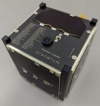
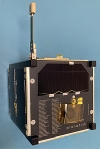
|
Planetum-1
#52738
(2022-057G) |
Planetum 1 is a
1U Cubesat designed by Planetum, a cluster of Prague
observatories and planetariums, to teach and popularize
astronomy and cosmonautics. The control center in the
Prague Planetarium will be open to school excursions,
as well as to various workshops.
Planetum1 features
an active orientation system that allows precise maneuvering
as well as pointing of the satellite camera with an
accuracy better than 1.5°. The satellite also is
equipped with a device to measure the Earth's magnetic
field.
Spacemanic has been
chosen to build Planetum-1. Spacemanic is also in charge
of design, integration, launch procurement, and launch
campaign. Spacemanic will also help with operations,
that will use proprietary ground station solution.
The communication
with the satellite takes place via radio signals on
amateur radio frequencies which allow radio amateurs
to receive transmissions and data from the satellite. |
May
25th 2022 |
1
kg |
 On July
22nd 2022 at 13:04 UTC Daniel
DL7NDR received on 436.680 MHz the 9600bd GFSK beacon.
Recording kindly provided by Daniel DL7NDR. On July
22nd 2022 at 13:04 UTC Daniel
DL7NDR received on 436.680 MHz the 9600bd GFSK beacon.
Recording kindly provided by Daniel DL7NDR.
|
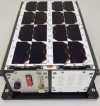
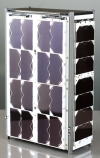

|
Platform-1
SharedSat_2141
SharedSat 2
#52770
(2022-057AQ) |
Platform-1 (SharedSat_2141)
is a commercial 6U cubesat from EnduroSat in Bulgaria
providing access to Space for several customer payloads
for Earth Observation and data processing. It was launched
on the Transporter-5 mission on May 25th 2022
by a SpaceX Falcon-9. In addition to its control and
data downlink channels, it emits periodic beacons in
AX.25 format in the commercial UHF range. |
May
25th 2022 |
~
7 kg |
 The download
signal of Platform-1 was received on September 10th
2024 at 16:45UTC on 400.360 MHz by Igor PU4ELT. It is
comprised of a melody "The Imperial March"
(Star Wars) followed by 2 packets of 4800bps GFSK AX.25
G3RUH. The download
signal of Platform-1 was received on September 10th
2024 at 16:45UTC on 400.360 MHz by Igor PU4ELT. It is
comprised of a melody "The Imperial March"
(Star Wars) followed by 2 packets of 4800bps GFSK AX.25
G3RUH.
Recording kindly provided by
Igor PU4ELT. |
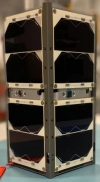
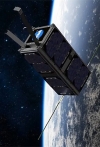
|
SelfieSat
#53951
(2022-057BB) |
The Norwegian SelfieSat
is a 2 unit CubeSat mission built by Orbit NTNU, a volunteer
student organization educating future space engineers
at the Norwegian University of Science and Technology
(NTNU).
The purpose of the
satellite is to display a selfie of any person on earth,
which will be uploaded from the ground station at NTNU.
The external LCD-display displays pictures sent in by
the public. A camera mounted on a measuring tape arm
photographs the screen with the Earth in the background.
The space-selfie will be sent back to Earth. SelfieSat
is equipped with 5 cameras; one selfie-camera, two on
the sides (x- and y-) and one on the antennas-side.
Through
SelfieSat, Orbit will gain unique experience in building
satellites and launching them to space.
The satellite was
launched on May 25th 2022
by a Falcon-9 v1.2 (Block 5) rocket on the Transporter-5
rideshare mission onboard of the Vigoride 3 space tug
and was deployed at the end of August 2022. |
May
25th 2022 |
1.8
kg |
 On January
8th 2023 at 13:15 UTC Daniel
DL7NDR received on 437.500 MHz the 9600bd FSK beacon.
Recording kindly provided by Daniel DL7NDR. On January
8th 2023 at 13:15 UTC Daniel
DL7NDR received on 437.500 MHz the 9600bd FSK beacon.
Recording kindly provided by Daniel DL7NDR.
|
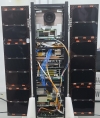
|
RANDEV
ASTRIS 2
#52898
(2022-065E) |
RANDEV (Repeater
Arrangement & Disaster Early View)) is a South Korean
3U-CubeSat designed by Korea Advanced Institute of Science
and Technology (KAIST). RANDEV conducts an earth observation
mission to collect potential hazard image data from
volcanoes, coasts, and clouds. Payloads are hyper-spectral
camera, S-band receiver, UHF- and X-band transmitter.
The antennas are used to conduct store & forward
and satellite internet missions. |
June
21st 2022 |
~3
kg |
 On October
31st 2023 at 15:25 UTC Daniel
DL7NDR received on 436.030 MHz the 1200bd BPSK beacon.
Recording kindly provided by Daniel DL7NDR. On October
31st 2023 at 15:25 UTC Daniel
DL7NDR received on 436.030 MHz the 1200bd BPSK beacon.
Recording kindly provided by Daniel DL7NDR.
|
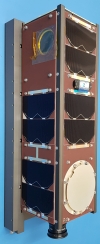
|
MIMAN
Cubesatyonsai
#52900
(2022-065G) |
MIMAN (Monochrome
Imaging for Monitoring Aerosol by Nanosatellite) is
a South Korean 3U-CubeSat (10 cm × 10 cm ×
34 cm ) for monitoring fine dust on the Korean Peninsula
designed by Yonsei University. It is equipped with an
optical camera and antennas for communication. It transmits
images with a resolution of 200 m or less in the area
of 400 km × 400 km above the West Sea once every
two days to the ground. The image sent down to the ground
is provided to the fine dust research team after appropriate
correction so that it can be used as research data. |
June
21st 2022 |
~3
kg |
 On August
21st 2022 at 15:23 UTC Daniel
DL7NDR received on 436.500 MHz the 2400bd GMSK beacon.
Recording kindly provided by Daniel DL7NDR. On August
21st 2022 at 15:23 UTC Daniel
DL7NDR received on 436.500 MHz the 2400bd GMSK beacon.
Recording kindly provided by Daniel DL7NDR.
|
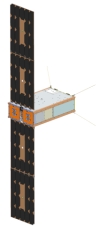

|
CTIM-FD
CTIM
#52950
(2022-074G) |
CTIM-FD (Compact
Total Irradiance Monitor Flight Demonstration) is a
6U CubeSat technology demonstration mission of a next-generation
Compact Total Irradiance Monitor that will help to provide
an understanding of Earth’s climate change by the University
of Colorado at Boulder.
Incoming radiant
energy from the sun is measured as the total solar irradiance,
which is a natural factor that changes our climate (also
called a climate forcing). Total solar irradiance has
been measured from space by a 40-year, uninterrupted
sequence of instruments. CTIM will allow measurements
to be made with the same accuracy and long-term stability
while using a much smaller instrument.
Lighter and more
compact, CTIM features several improvements to the original
TIM design. In particular, CTIM’s novel Vertically Aligned
Carbon Nanotube (VACNT) bolometers mark a significant
milestone in the quest to develop lightweight components
for CubeSat-compatible instruments. These silicon-based
bolometers will dramatically reduce the weight of the
CTIM CubeSat without compromising its ability to measure
the total irradiance of the sun (200 – 2400 nm) with
an uncertainty of <0.01% and a stability of <0.001%/year.
CTIM decayed on
December 3rd 2023. |
July
2nd 2022 |
~6
kg |
 On August
27th 2022 at 15:28 UTC Daniel
DL7NDR received on 437.250 MHz the 9600bd GFSK beacon.
Recording kindly provided by Daniel DL7NDR. On August
27th 2022 at 15:28 UTC Daniel
DL7NDR received on 437.250 MHz the 9600bd GFSK beacon.
Recording kindly provided by Daniel DL7NDR.
|

|
VIZARD
Vizard-SS1
SXC3-215
SPACE-PI 16
RS33S
#53386
(2022-096S) |
Vizard SS1 is a
Russian 3U CubeSat by the Moscow companies Vizard and
NIS LLC. It carries AIS and KINEIS payloads for Arctic
studies.
The payload of the
satellite consists of a device for the international
system of the Internet of Things KINEIS and an automatic
vessel identification system.
Students of Moscow
schools took part in the development of the payload.
They worked on the project in engineering and IT classes
at schools, as well as at the Center for Youth Innovative
Creativity at the Science Park of Moscow State University. |
Aug.
9th 2022 |
2.34
kg |
 On September
3rd 2022 at 08:45 UTC Daniel
DL7NDR received on 437.800 MHz the 2400bd GMSK beacon.
Recording kindly provided by Daniel DL7NDR. On September
3rd 2022 at 08:45 UTC Daniel
DL7NDR received on 437.800 MHz the 2400bd GMSK beacon.
Recording kindly provided by Daniel DL7NDR.
|

|
KUZBASS-300
SXC3-218
SPACE-PI 5
RS34S
#53375
(2022-096F) |
Kuzbass-300 is a
Russian 3U CubeSat developed by regional students, scientists
and students of the Kuzbass State Technical University
(KuzGTU) on the satellite CubeSat platform OrbiCraft-Pro
SXC3 of SPUTNIX (a member of Sitronics Group). It will
carry out remote sensing of the Earth, conduct fire
monitoring in the region and throughout the Russian
Federation.
The payload of the
satellite will allow::
- conduct research
and observations,
- monitor changes
occuring on the Earth’s surface using a special camera
The satellite's
equipment will transmit telemetry data, voice messages,
and images to Earth! It is a kind of broadcast ad from
space, in which all the inhabitants of the Earth are
invited to Kuzbass, to an event within the global Yuri‘s
Night movement. |
Aug.
9th 2022 |
3.03
kg |
 On September
3rd 2022 at 10:39 UTC Daniel
DL7NDR received on 437.700 MHz the 2400bd GMSK beacon.
Recording kindly provided by Daniel DL7NDR. On September
3rd 2022 at 10:39 UTC Daniel
DL7NDR received on 437.700 MHz the 2400bd GMSK beacon.
Recording kindly provided by Daniel DL7NDR.
|
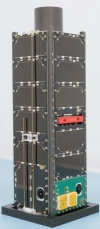
|
KAI-1
SPACE-PI 8
RS26S
#53378
(2022-096J) |
KAI 1 is a Russian
3U CubeSat developed by the employees of NILACT DOSAAF
LLC, KNITU-KAI University is being prepared to launch
with the involvement of lyceumists of KNITU-KAI SUNC.
The CubeSat developers
faced the following tasks:
-
Place on the satellite complex of cameras
from which images will be transmitted to the ground
complex. As a result of image processing, panoramic
images of space (180-270 degrees) around the satellite
will be formed.
- Install a unique thermometer on
the surface and inside of the satellite, made on the
basis of a fiber Bragg grater (under the guidance of
Kuznetsov A.A., Associate Professor of Photonics and
Microwave Technologies of IRET).
For amateur radio
service, the satellite can transmit a presence signal
(beacon) in Morse code format and AX format in the format
of AX.25 AFSK1200. Beacon frequencies: 435665 kHz, 435765
kHz. Additionally, each of the two on-board radio transmitters
can be switched to the CM mode of the 145 MHz-435 MHz
transmitter, allowing radio amateurs to broadcast for
thousands of kilometers. |
Aug.
9th 2022 |
3.6
kg |
 On September
9th 2022 at 09:58 UTC Daniel
DL7NDR received on 435.665 MHz the 1200bd AFSK beacon.
Recording kindly provided by Daniel DL7NDR. On September
9th 2022 at 09:58 UTC Daniel
DL7NDR received on 435.665 MHz the 1200bd AFSK beacon.
Recording kindly provided by Daniel DL7NDR.
|
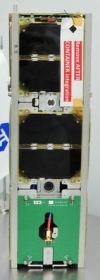
|
CUBESX-HSE-2
SXC3-213
SPACE-PI 13
RS21S
#53383
(2022-096P) |
CubeSX-HSE 2 is
a 3U CubeSat, built on the OrbiCraft-Pro 3U platform
of the SPUTNIX (part of the Sitronics Group). The spacecraft
consists of three units built on a single frame. One
of the units holds the propulsion system, the second
includes all boards for the satellite's operation, and
the third carries the payload - an experimental camera
for remote sensing of the Earth and the Automatic Identification
System (IAS) for monitoring ships at sea. The satellite
will monitor the Earth's surface in the Arctic region,
and will also be part of a tracking system for ship
movement along the Northern Sea Route. The satellite
control systems will be tested by the Moscow Institute
of Electronics and Mathematics (MIEM) staff and students. |
Aug.
9th 2022 |
3.39
kg |
 On September
9th 2022 at 09:44 UTC Daniel
DL7NDR received on 435.570 MHz the 2400bd GMSK beacon.
Recording kindly provided by Daniel DL7NDR. On September
9th 2022 at 09:44 UTC Daniel
DL7NDR received on 435.570 MHz the 2400bd GMSK beacon.
Recording kindly provided by Daniel DL7NDR.
|
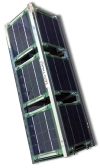
|
CYCLOPS
VOENMEH
SXC3-2110
SPACE-PI 3
RS29S
#53373
(2022-096D) |
CYCLOPS is a Russian
3U CubeSats with an technology mission developed by
D.F. Ustinov “MMI” (Military Mechanical Institute) BSTU
with the joint participation of schoolchildren, students
and university staff. The CYCLOPS spacecraft was developed
on the OrbiCraft-Pro SXC3 satellite CubeSat platform
of the SPUTNIX company (part of the Sitronics Group).
CYCLOPS satellite
will carry out the following experiments:
-
stabilization and positioning of its optical
device;
- observation of the Earth's surface;
- investigation
of the properties and efficiency of energy storage;
- technical solutions development for creating a lunar
rover;
- a study of degradation of the characteristics
of materials and parameters of electronic devices in
outer space. |
Aug.
9th 2022 |
2.59
kg |
 On September
17th 2022 at 08:39 UTC Daniel
DL7NDR received on 436.050 MHz the 2400bd FSK beacon.
Recording kindly provided by Daniel DL7NDR. On September
17th 2022 at 08:39 UTC Daniel
DL7NDR received on 436.050 MHz the 2400bd FSK beacon.
Recording kindly provided by Daniel DL7NDR.
|

|
UTMN
SXC3-216
SPACE-PI 6
RS23S
#53376
(2022-096G) |
UTMN is a Russian
3U CubeSats with an environmental mission developed
by Samara Medex. Pupils, students and scientists of
the Tyumen State University (TSU) together developed
the satellite, and the satellite itself was created
on the OrbiCraft-Pro SXC3 satellite CubeSat platform
of SPUTNIX (part of Sitronics Group).
CubeSat UTMN is
equipped with a camera which allows:
-
investigate oil spills in the Arctic,
- transfer photos to the ground,
- predict the development
of the ecological situation in this region.
Subsequent processing
of images using computer algorithms will allow observations
and forecasts on the environmental situation in the
Arctic. |
Aug.
9th 2022 |
3.07
kg |
 On September
3rd 2022 at 09:07 UTC Daniel
DL7NDR received on 435.670 MHz the 9600bd GMSK beacon.
Recording kindly provided by Daniel DL7NDR. On September
3rd 2022 at 09:07 UTC Daniel
DL7NDR received on 435.670 MHz the 9600bd GMSK beacon.
Recording kindly provided by Daniel DL7NDR.
|

|
ISOI
SXC3-219
SPACE-PI 11
RS19S
#53381
(2022-096M) |
ISOI is a Russian
3U CubeSat developed by employees of the Samara Medex
company, as well as students and scientists of the Crystallography
and Photonics Research Center of the Russian Academy
of Sciences together with a research team from Samara
University on the OrbiCraft-Pro SXC3 satellite CubeSat
platform of the SPUTNIX company (part of the Sitronics
Group).
ISOI carries a hyperspectral
imager. The data obtained from this satellite’s camera
will help to build and perform static analysis of hyperspectral
images by video sequences, geo-linking of hyperspectral
images, calculation of the humidity index, NDVI, and
other vegetative indices. |
Aug.
9th 2022 |
3.47
kg |
 On September
3rd 2022 at 09:29 UTC Daniel
DL7NDR received on 435.650 MHz the 2400bd GMSK beacon.
Recording kindly provided by Daniel DL7NDR. On September
3rd 2022 at 09:29 UTC Daniel
DL7NDR received on 435.650 MHz the 2400bd GMSK beacon.
Recording kindly provided by Daniel DL7NDR.
|

|
MIET-AIS
SXC3-314
SPACE-PI 7
RS28S
#53377
(2022-096H) |
MIET-AIS is a Russian
3U CubeSats with an technology mission developed by
students and scientists of the Moscow Institute of Electronic
Technology (MIET) as part of a project on the OrbiCraft-Pro
SXC3 satellite CubeSat platform of SPUTNIX (part of
the Sitronics Group).
The main purpose
of the payload is to receive signals from AIS transmitters
installed on ships for the purpose of their subsequent
analysis. The information obtained is necessary to prevent
collisions of ships, control their movement and use
the data in search and rescue operations.
The MIET satellite
is also equipped with an experimental plasma propulsion
system developed by MEPhI. |
Aug.
9th 2022 |
3.39
kg |
 On September
3rd 2022 at 10:39 UTC Daniel
DL7NDR received on 437.900 MHz the 2400bd GMSK beacon.
Recording kindly provided by Daniel DL7NDR. On September
3rd 2022 at 10:39 UTC Daniel
DL7NDR received on 437.900 MHz the 2400bd GMSK beacon.
Recording kindly provided by Daniel DL7NDR.
|

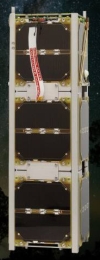
|
SIREN
LILAC
SXC3-217
RS30S
#53384
(2022-096Q) |
Siren
is a Russian 3U CubeSats with a biology mission developed
by the Engineering Center of BSU within the frameworks
of the “SPACE-p” project, supported by FASIE on the
OrbitCraft-Pro SXC3 CubeSat satellite of “SPUTNIX” (a
member of Sitronics Group), the team “Engineering Center
of BSU“ has developed a payload that will allow them
to investigate the state of lilac sprout growth in space."
The following downlink frequency
has been reported: 437.750
MHz in GMSK 2400 + 9600 bps.
This
frequency was not coordinated by IARU and thus the satellite
transmitted illegally in the Ham Radio band.
SXC3-217 decayed on July 6th
2024. |
Aug.
9th 2022 |
3.22
kg |
 The 9k6
download of SIREN was received on July 3rd
2024 at 03:14UTC on 437.750MHz by Igor PU4ELT. The 9k6
download of SIREN was received on July 3rd
2024 at 03:14UTC on 437.750MHz by Igor PU4ELT.
Recording kindly provided by
Igor PU4ELT. |
 On September
3rd 2022 at 08:54 UTC Daniel
DL7NDR received on 437.750 MHz the 4800bd GMSK beacon.
Recording kindly provided by Daniel DL7NDR. On September
3rd 2022 at 08:54 UTC Daniel
DL7NDR received on 437.750 MHz the 4800bd GMSK beacon.
Recording kindly provided by Daniel DL7NDR.
|

|
BlueWalker-3
BW3
#53807
(2022-111AL) |
BlueWalker 3 is
prototype satellite for AST & Science's SpaceMobile
mobile communications constellation.
The satellite will
be to test AST & Science's patented technologies
for connecting to cellphones in a space environment
for their planned SpaceMobile constellation. The ~ 1.5
ton satellite will deploy a 10 m diameter phased array
antenna with 64 m2 area consisting of numerous identical
sub-antenna modules to connect directly to standard
mobile phones.
It is a prototype
for the larger operational BlueBird satellites. The
first five BlueBird satellites will be similar to BlueWalker
3, while the remaining will be larger.
Bluewalker is illegally
using Amateur Radio frequencies. |
Sept.
11th 2022 |
1500
kg |
 On October
3rd 2022 at 15:24 UTC Daniel
DL7NDR received on 437.500 MHz the 2400bd FSK beacon.
Recording kindly provided by Daniel DL7NDR. On October
3rd 2022 at 15:24 UTC Daniel
DL7NDR received on 437.500 MHz the 2400bd FSK beacon.
Recording kindly provided by Daniel DL7NDR.
|
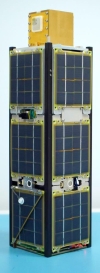
|
UmKA-1
YMKA-1
RS40S
#57172
(2023-091G) |
UmKA-1 3U Cubesat
was created by the team of the Center for Scientific
Creativity of the Podolsk High School ?29. The device
is assembled on the basis of the OrbiCraft-Pro platform.
The payload elements
are the high-aperture Leptonar-20955K telescope and
the PlayerOne Saturn-C SQR astronomical digital camera.
Before placing them in the satellite body, the project
participants took pictures of the Cygnus constellation,
as well as the Andromeda nebula from Earth.
UmKA-1 is transmitting
on the following frequencies:
Main UHF beacon:
437.625
MHz 2k4, 4k8 and 9k6 GMSK USP & SSTV Robot72, Robot36,
Robot24, B/W12 e B/W8
Secondary UHF beacon:
435.825 MHz 4k8 9k6 GMSK USP
S-band downlink:
2402.400 MHz BPSK 2Mbps |
Jnne
27th 2023 |
4
kg |
  This SSTV
image from UMKA-1 was received on 437.625 MHz on June
20th 2024 at 11:43UTC by Igor
PU4ELT. This SSTV
image from UMKA-1 was received on 437.625 MHz on June
20th 2024 at 11:43UTC by Igor
PU4ELT.
Recording and picture kindly
provided by Igor PU4ELT. |
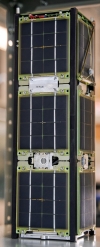
|
UTMN-2
SPACE-PI
RS27S
#57203
(2023-091AP) |
Satellite
of the Tyumen State University for environmental monitoring
of the Tyumen region. The spacecraft was assembled as
part of a project for remote diagnostics of the troposphere
and water bodies using satellite infrared thermometry.
The payload was developed at SINP MSU.
I am searching for sound files. Please send
them to
 |
July 26th
2023 |
3.97 kg |
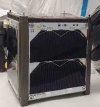
|
HAYASAT-1
EK1HYS
#58471
(2023-185K) |
Hayasat-1
(EK1HYS) is a 1U cubesat developed jointly by the Bazoomq
and CSIE research laboratories, based in Yerevan, Armenia.
It weighs approximately 1 kg and was launched on December
1st 2023
by a Falcon-9 from the Vandenberg Space Base in the
USA.
Hayasat-1 is positioned
in an orbit with 97 inclination and and
470 km perigee.
The satellite shall
transmit at the following frequency: 437.020 MHz (Possible
drift for 437.019MHz) FSK G3RUH 9k6 + Melody + CW. |
Dec.
1st 2023 |
1
kg |
 HAYASAT-1
was received on August 21st
2024 at 00:39UTC by Igor PU4ELT. HAYASAT-1
was received on August 21st
2024 at 00:39UTC by Igor PU4ELT.
Recording kindly provided by
Igor PU4ELT. |
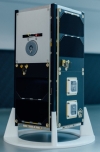
|
GRBBeta
#60237
(2024-128C) |
GRBBeta
is a 2U CubeSat mission, a technology demonstration
with an improved gamma-ray detector subsystem, an experimental
UV camera, and various platform-side features including
an attitude determination and control subsystem. Amateur
radio services are provided in VHF and UHF bands while
an experimental S-band TX system aids the higher bandwidth.
The
dimensions of the satellite in the folded state (without
unfolded antennas) are 10 cm x 10 cm x 22.7 cm. The
weight is 2.48 kg.
GRBBeta was established
with the financial support of the Ministry of Education,
Research, Development and Youth of the Slovak Republic.
The project is the holder of the project is the Technical
University of Košice, the Faculty of Aerobic and the
partners from various foreign institutions cooperate
on the project.
In addition to its
scientific experiments, it has a digital radio for radio
amateurs. Thus radio amateurs will be able to send messages
through the satellite which is using the callsign HA2GRB.
The
downlinks are:
UHF Downlink : 436.785
MHz +/- Doppler shift
VHF Downlink : 145.935
MHz +/- Doppler Shift
S-Band Downlink
: 2405.000 MHz +/- Doppler Shift
Modulation
: GMSK, CW G3RUH 9k6 baud (UHF, VHF)
Morse:
20 WPM
Protocols:
AX.25, Morse
Broadcast
power: 1W (30dBm)
Antenna:
dipole (linear polarization) |
July
9th 2024 |
2.48
kg |
 The CW
beacon of GRBBeta was received on July 10th
2024 at 17:25UTC on 436.778Mhz by Igor PU4ELT. The CW
beacon of GRBBeta was received on July 10th
2024 at 17:25UTC on 436.778Mhz by Igor PU4ELT.
Recording kindly provided by
Igor PU4ELT. |
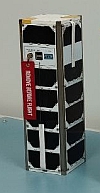

|
RUZAEVKA-390
RS44S
#99194
prelim
(2024-xxxx) |
Ruzaevka-390 (RS44S)
is a 3U cubesat that is part of the Space-p
program . It was launched on November 4th 2024 at 23:18UTC
by a Soyuz-2.1b/Fregat from the Vostochny cosmodrome.
RS44S
transmits
on the following frequencies:
437.865 MHz LoRa
437.050
MHz SSTV + AFSK 1k2
435.750MHz FSK 2k4
435MHz/145MHz
FM-transponder
Even
though it uses Amateur Radio frequencies it is not a
legal Amateur Radio satellite as it has not been coordinated
by IARU. |
Nov
4th 2024 |
3
kg |
  The SSTV
signal of RS44S was received and decoded on November
6th 2024 at 11:48UTC on 437.050Mhz
by Igor PU4ELT. The SSTV
signal of RS44S was received and decoded on November
6th 2024 at 11:48UTC on 437.050Mhz
by Igor PU4ELT.
Recording and image kindly provided
by Igor PU4ELT. |
Picture |
Object
name
#NORAD |
Description |
Launch
Date |
Weight |